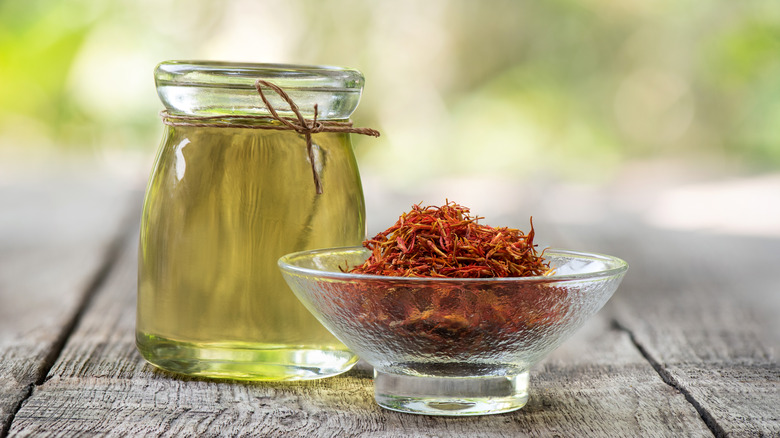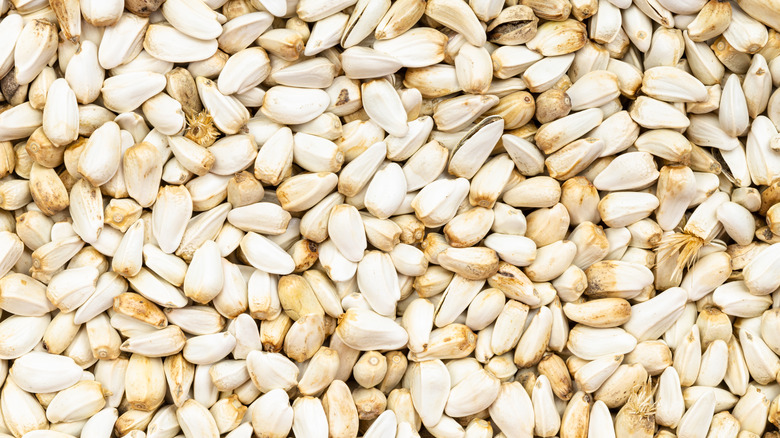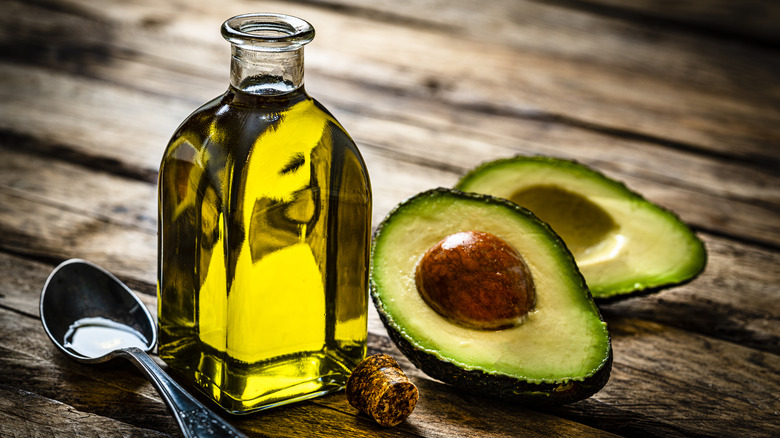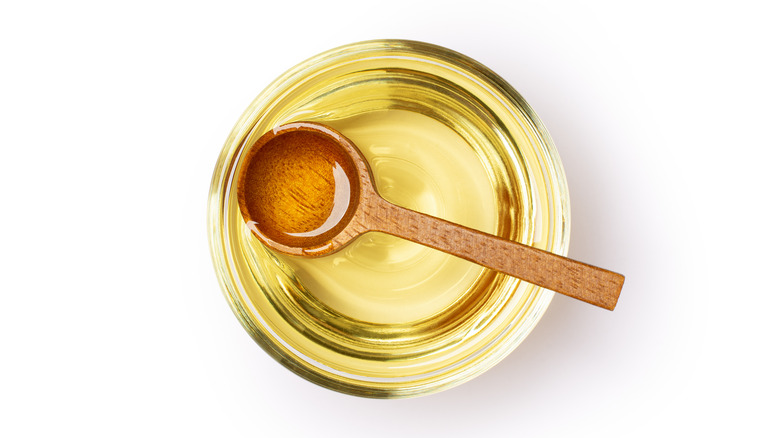The Unique Neutral Oil With One Of The Highest Smoke Points
We may receive a commission on purchases made from links.
You've probably heard by now that avocado oil has a higher smoke point than olive oil and is ideal for sautéing food at high heat. Well, there's another oil you may not be familiar with that possesses an equally high smoke point as well as a neutral flavor — safflower oil. While olive oil will start smoking at a mere 375 degrees Fahrenheit, avocado oil can withstand temperatures of 520 degrees, and safflower oil typically smokes between 440 and 520 degrees Fahrenheit. To be clear, we're primarily talking about high-oleic safflower oil here. Although high-linoleic safflower oil does exist, that slightly different version may start smoking as low as 225 degrees.
What exactly is this lesser-known, high-heat tolerant cooking fat? Safflower oil comes from the seeds of the safflower plant which has vibrant, orange-yellow flowers that are used to make red dye for clothing. Because it's similar in color to saffron, the safflower plant can also be made into a spice known as the "poor man's saffron," according to MasterClass. As a spice, however, it has a very mild flavor. The oil is where the safflower plant really shines — so, if you've never used it before, take a look at everything it can offer.
What is safflower oil?
The scientific name for safflower is Carthamus tinctoris. As a member of the Asteraceae plant family, it's a close relative of other flowering plants like marigolds, dandelions, and sunflowers, and also foods like lettuce and artichokes. The plant originally comes from Asia, Africa, and the Middle East. Safflower was harvested all the way back in 2000 BCE when merchants from Egypt sold it to neighboring continents. It had a plethora of colorful uses back in the day — ancient Egyptians used it to dye bindings for mummies, comfort the dead in the afterlife, and even make eyeliner.
Safflower wasn't cultivated in the U.S. until 1925. Today it's grown in Utah, Colorado, Idaho, North Dakota, and Montana, although much of American safflower comes from California. While the plant itself grows beautiful, yellow-orange flowers and the spice is a fiery orange-red, the oil is very light yellow in color, almost clear. Over time, it becomes even less yellow. Aside from its culinary uses, it's used in the modern day as a skincare ingredient and to dilute essential oils.
How is safflower oil made?
Safflower oil comes from the seeds of the safflower plant. The seeds look fairly similar to sunflower seeds — they're small, long, and somewhere in between light brown and white. Each seed can contain as little as 15% oil or as much as 35%. To squeeze it out, processing plants typically pulverize or press safflower seeds, although solvents like hexane and methanol can also be used. There are concerns that chemical solvents like hexane are harmful to the environment, according to the E3S Web of Conferences, so another method has been introduced called aqueous enzymatic extraction which uses water to obtain the oil.
For a basic extraction process using a press, the seeds need to be shelled then steamed so they become tender enough to get the oil out. Once the oil has been obtained, it typically gets filtered to remove any remaining dirt. Some safflower oil is refined as the final step, which involves subjecting it to high heat and filtering it once again.
Safflower oil vs. avocado oil
Safflower and avocado oils are often compared because of their almost identical smoke points and relatively neutral flavor. Refined avocado oil is also a pale yellow, similar to safflower oil, while the unrefined version has more of a green hue. If you're looking to sauté or pan fry foods at high heat, these two are basically interchangeable, although avocado oil has slightly more flavor than safflower.
Of course, they come from two different plants; safflower oil comes from the seeds of the safflower plant and avocado oil from the pulp of the avocado fruit. While the seeds are typically pressed to make the former, avocado flesh is crushed into a paste to make the latter. It then undergoes malaxation, just like olives do when making olive oil, where it's heated and mixed slowly to separate the oil. During this process, smaller drops of oil glom onto bigger ones, which allows them to break away from the rest of the fruit more easily — so the longer the malaxation goes on, the more oil you'll typically get.
Nutritionally, both oils contain high amounts of vitamin E. Safflower oil also offers lower amounts of saturated fats than avocado oil, aka the "bad" fats, however, both have high amounts of monounsaturated fats, aka the "good" ones. But according to Healthline, there are few health benefits associated with safflower oil, while avocado oil has been shown to help reduce cholesterol, improve heart health, and promote healthy eyes.
What does safflower oil taste like?
In short, safflower oil tastes like nothing, which is kind of the point. It has all the silkiness that you would associate with a cooking oil, and it may even have a lighter and less greasy texture than other oil options. Unlike the plant's flowers, which are sweet with floral and chocolaty notes, safflower oil has a neutral taste that some compare to canola oil, meaning it won't alter the flavor of your recipe. Compared to canola oil, which is high in saturated fats, safflower oil may be a more nutritious neutral option. It can also work as a substitute for grapeseed or vegetable oil made from soybeans.
Just like its almost non-existent taste, safflower oil has virtually no smell. When heated, the flavor and smell stay the same, so you can trust that it will remain a background ingredient at any point in the cooking process.
How to cook with safflower oil
One of the best parts about safflower oil is that you can use it as a fat when cooking almost anything, as long as you're not relying on your oil for significant flavor. Because of its high smoke point, it's a great option for a stir-fry like this Spicy Beef Stir Fry recipe, or for sautéing or deep-frying. You can even use it in dessert recipes that call for deep-frying in vegetable oil, such as these deep-fried bananas. If you don't want your fat to mess with the flavor or your dish too much, safflower oil's neutral taste and smell make it an ideal choice.
For the same reasons, you can even use it as a fat in baking. Again it can substitute for vegetable oil in most baking recipes at a 1:1 ratio, so you can use it in quick breads, cakes, muffins, and more. In salad dressings, safflower oil is more functional than it is flavorful, and it will really let the taste of the other ingredients shine. And if you're making a condiment like classic mayonnaise or copycat Kewpie mayo that uses vegetable oil, you can easily swap that out for safflower oil to keep the fat's flavor in the background.
Where to buy safflower oil
Although safflower oil is one of the lesser-used cooking fats in the U.S., it isn't hard to find here. It's available at major grocery stores like Walmart, Vons, and Albertsons, and you can buy it online at Amazon where it's available in one gallon containers. Since it's occasionally used in skincare, you may also find it in specialty stores like The Vitamin Shoppe, where it's sold as a cold pressed skincare product. While it shouldn't be too hard to get your hands on a bottle anytime of year, it may be the most plentiful in the fall, since that's when the safflower plant is harvested.
Like with most other cooking oils, you can keep your bottle in the pantry or any other dark, dry place in your kitchen. It can last this way for up to two years, or six months if you keep it in the fridge. Be sure to keep your bottle away from the stove or oven, since proximity to heat can cause the oil to spoil more quickly.
Nutritional information about safflower oil
Since safflower oil has such a high smoke point, its nutritional benefits may actually be higher than those with lower smoke points, at least in one specific area. Safflower oil is full of monounsaturated fats, which won't break down during high heat cooking the way polyunsaturated fats may. It also contains plenty of omega-6 fatty acids and vitamin E, which is where its main nutritional content lies. Just one tablespoon of the cooking fat will give you 32% of your daily recommended intake of vitamin E.
Further health benefits of safflower oil are still up for debate. Its vitamin E may help boost the immune system, notes Healthline, but its linoleic acid may potentially increase neuroinflammation as well as inflammation in other areas of the body. High-oleic acid safflower oil may be a more beneficial choice, since it has lower quantities of linoleic acid. However, Medical News Today shares that cooking with safflower oil is a great way to get the good unsaturated fatty acids that can help with memory, hormone regulation, and heart health.
High-linoleic vs. high-oleic safflower oil
Safflower oil is typically sold in two varieties: high-linoleic and high-oleic. For most of this discussion, we've been referring to high-oleic safflower oil. It has a high smoke point of up to 520 degrees Fahrenheit and can be used for stir-frying, deep-frying, and in other dishes that need to be cooked at high heat. As mentioned, the high-oleic version is also higher in monounsaturated fats. In fact, high-oleic products were developed specifically by scientists to contain a large quantity of these good fats. In 2018, the U.S. Food and Drug Administration (FDA) claimed that the consumption of these oils has the potential to reduce the risk of coronary heart disease.
High-linoleic safflower oil is a different story, though. It contains more polyunsaturated fats than monounsaturated fats, which gives the refined version a much lower smoke point of 320 degrees Fahrenheit. In its natural, high-linoleic state, safflower oil contains about 75% linoleic acid and is mostly used in products like margarine. Per Healthline, there is evidence to suggest that too much linoleic acid intake can lead to health conditions like heart disease — so if you're looking to buy a bottle, it may be a more strategic move to choose a high-oleic version.








